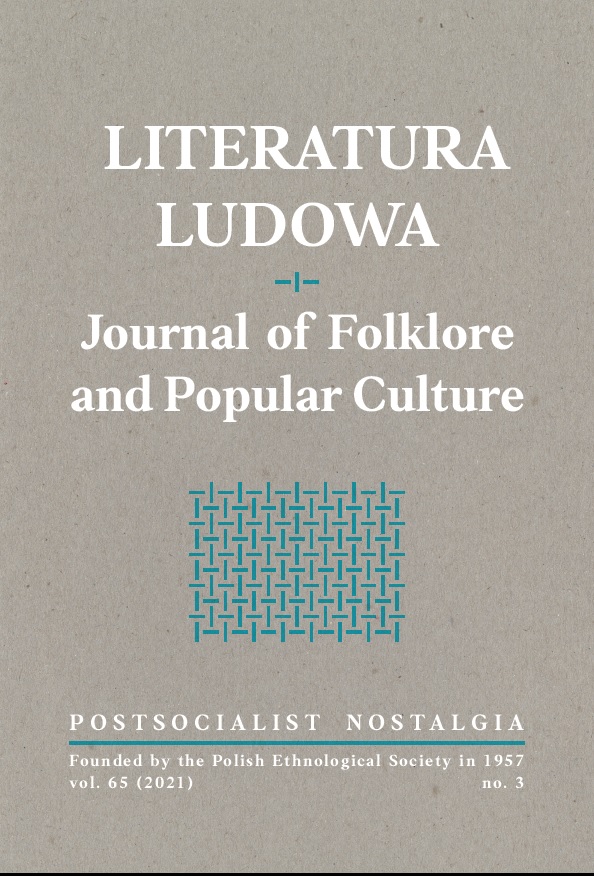Meble z biografią. Minimalizm, recykling i nostalgia we współczesnych praktykach zamieszkiwania
DOI:
https://doi.org/10.12775/LL.3.2021.006Słowa kluczowe
praktyki zamieszkiwania, biografia przedmiotów, minimalizm, nostalgia, PRLAbstrakt
Artykuł prezentuje refleksję dotyczącą relacji łączących ludzi i przedmioty materialne w oparciu o wyniki badań etnograficznych dotyczących praktyk zamieszkiwania w przestrzeni polskich miast. Głównym przedmiotem analiz podejmowanych przez autorkę są sposoby funkcjonowania mebli pochodzących z okresu PRL-u we współczesnych wnętrzach mieszkalnych, jako przedmiotów z bogatą kulturową biografią, które aktywnie uczestniczą we współczesnych praktykach zamieszkiwania oraz pełnią istotną rolę w budowaniu poczucia tożsamości ich obecnych właścicieli i użytkowników. Autorka dostrzega związki pomiędzy nostalgicznym powrotem do artefaktów z okresu PRL-u, a aktualnymi problemami i wyzwaniami społecznymi, głównie nadprodukcją rzeczy i koniecznością powstrzymania zmian klimatu. Nostalgia w tych rozważaniach pojmowana jest jako swoisty mechanizm obronny przeciwko przyspieszonemu rytmowi zachodzących w świecie zmian, w tym zmian klimatycznych i środowiskowych; stanowi też wyraz kontestacji myślenia o ludzkim życiu wyłącznie przez pryzmat kategorii czysto ekonomicznych.
Bibliografia
Biskupska, K. (2014). Konsola była kiedyś stołem, czyli o wątkach przeszłości w mieszkaniu estetycznym. Społeczeństwo i Ekonomia, 2(2), 7-22.
Bittner, K. (2017). Chcemy znów być nowocześni. Kilka uwag o popularności peerelowskiego wzornictwa przemysłowego. W: A. Kisielewska, M. Kostaszuk-Romanowska, A. Kisielewski (red.), PRL-owskie re-sentymenty (s. 237-252). Gdańsk: Wydawnictwo Naukowe Katedra.
Boym, S. (2002). Nostalgia i postkomunistyczna pamięć (przeł. L. Stefanowska). W: F. Modrzejewski, M. Sznajderman (red.), Nostalgia. Eseje o tęsknocie za komunizmem (s. 270-301). Wołowiec: Wydawnictwo Czarne.
Bryl-Roman, W. (2010). Polski vintage – odkrywanie peerelowskiego designu. W: M. Bogusławska, Z. Grębecka (red.), Popkomunizm. Doświadczanie komunizmu a kultura popularna (s. 51-60). Kraków: Libron – Filip Lohner.
Burszta, W. (1997). Nostalgia i mit. W: E. Domańska (red.), Historia. O jeden świat za daleko (s. 119-130). Poznań: Instytut Historii Uniwersytetu Adama Mickiewicza.
Cobel-Tokarska, M. (2014). W jakiej Polsce żyliśmy? Historyczno-społeczne tło przemian obyczajowych w PRL-u. W: J. Zalewska, M. Cobel-Tokarska (red.), Od mody do obyczaju. Przemiany życia codziennego (s. 22-37). Warszawa: Wydawnictwo Akademii Pedagogiki Specjalnej.
cotozafotel (b.d.). Kredens typ 1050/B [post na blogu]. Pobrano z: https://cotozafotel.pl/kredens-typ-1050-b/
Czyńska, M. (2017). Dom polski. Meblościanka z pikasami. Wołowiec: Wydawnictwo Czarne.
Giddens, A. (2001). Nowoczesność i tożsamość. „Ja” i społeczeństwo w epoce późnej nowoczesności (przeł. A. Szulżycka). Warszawa: Wydawnictwo Naukowe PWN.
Ingold, T. (2018). Splatać otwarty świat. Architektura, antropologia, design (przeł. E. Klekot, D. Wąsik). Kraków: Instytut Architektury.
Jarosz, D. (2010). Mieszkanie się należy… Studium z peerelowskich praktyk społecznych. Warszawa: Oficyna Wydawnicza ASPRA-JR.
Jasiołek, K. (2020). Astroid i półkotapczan. O polskim wzornictwie powojennym. Warszawa: Wydawnictwo Marginesy.
Kopytoff, I. (2003). Kulturowa biografia rzeczy – utowarowienie jako proces (przeł. E. Klekot). W: M. Kempny, E. Nowicka (red.), Badanie kultury. Elementy teorii antropologicznej (s. 249–274). Warszawa: Wydawnictwo Naukowe PWN.
Krajewski, M. (2008). Ludzie i przedmioty – relacje i motywy przewodnie. W: J. Kowalewski, W. Piasek, M. Śliwa (red.), Rzeczy i ludzie. Humanistyka wobec materialności (s. 131–152). Olsztyn: Instytut Filozofii Uniwersytetu Warmińsko-Mazurskiego w Olsztynie.
Latour, B. (2020). Where to land after the pandemic? A paper and now a platform. Retrieved from: http://www.bruno-latour.fr/node/852.html
Minerwa (2018, 28 lipca). Ikony polskiego designu. Józef Chierowski i jego słynny fotel typ 366 [post na blogu]. Pobrano z: https://www.laminerva.pl/2018/07/chierowski-fotel-typ-366.html
Przedpełski, A. (1987). Instytut Wzornictwa Przemysłowego, W: M. Kulik (red.), Wzornictwo w Polsce (s. 59–75). Warszawa: Instytut Wzornictwa Przemysłowego.
Puchała, M. (1964). Meble współczesne. Warszawa: Wydawnictwo Przemysłu Lekkiego i Spożywczego.
Woroniecka, G. (2007). Wstęp. Co znaczy mieszkać. W: G. Woroniecka (red.), Co znaczy mieszkać. Szkice antropologiczne (s. 13-27). Warszawa: Wydawnictwo TRIO.
Woźniak, A. (2015). Śmieci na wsi? Krótka historia wiejskiego gospodarowania rzeczami zbędnymi. W: K. Kulikowska, C. Olbracht-Prądzyński (red.), Śmieć w kulturze (s. 601–632). Gdańsk: Wydawnictwo Naukowe Katedra.
Wybieralski, W. (2007). Wzornictwo w Polsce do 1989 roku na tle politycznym i gospodarczym. Warszawa: Akademia Sztuk Pięknych, Wydział Wzornictwa Przemysłowego.
Pobrania
Sklep wydawnictwa:
Opublikowane
Jak cytować
Numer
Dział
Licencja

Utwór dostępny jest na licencji Creative Commons Uznanie autorstwa – Bez utworów zależnych 4.0 Międzynarodowe.
Prawa autorskie/Copyright Notice
1. Autorzy udzielają wydawcy (Polskiemu Towarzystwu Ludoznawczemu) licencji niewyłącznej na korzystanie z utworu w następujących polach eksploatacji:a) utrwalanie Utworu/przedmiotu prawa pokrewnego;
b) reprodukowanie (zwielokrotnienie) Utworu/przedmiotu prawa pokrewnego drukiem i techniką cyfrową (ebook, audiobook);
c) wprowadzania do obrotu egzemplarzy zwielokrotnionego Utworu/przedmiotu prawa pokrewnego;
d) wprowadzenie Utworu/przedmiotu prawa pokrewnego do pamięci komputera;
e) rozpowszechnianie utworu w wersji elektronicznej w formule open access na licencji Creative Commons (CC BY - ND 3.0).
2. Autorzy udzielają wydawcy licencji nieodpłatnie.
3. Korzystanie przez wydawcę z utworu na ww. polach nie jest ograniczone czasowo, ilościowo i terytorialnie.
Statystyki
Liczba wyświetleń i pobrań: 547
Liczba cytowań: 0



